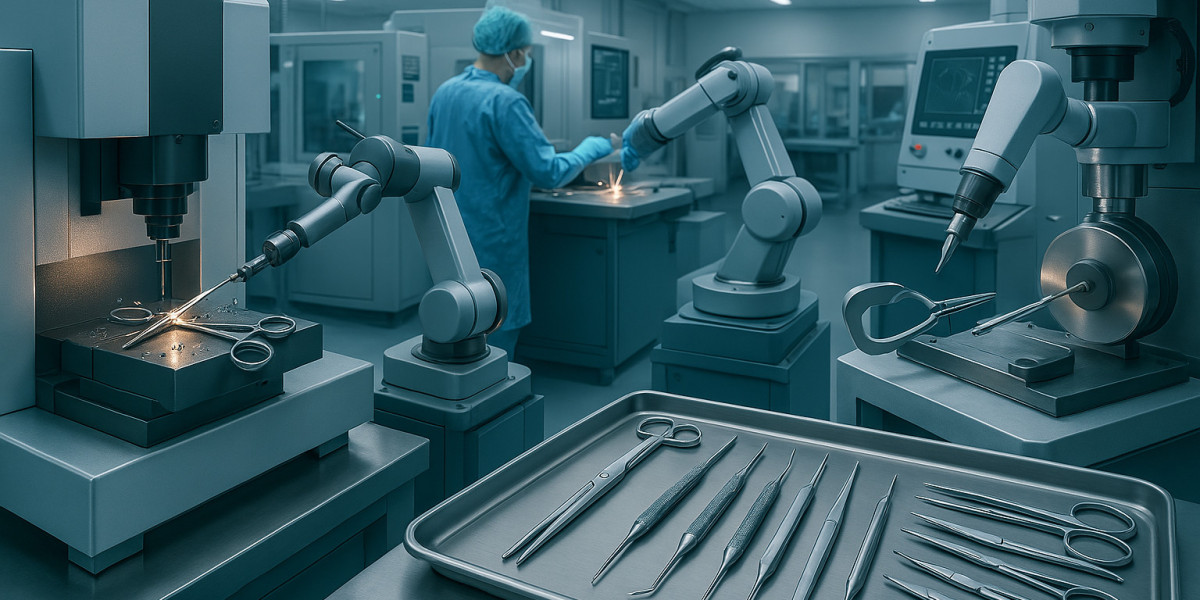Why Manufacturing Machines Matter in Surgery
Think about this—what’s the one thing a surgeon can’t perform without? Not just skill, not just training… it's the surgical instruments in their hands. Behind every scalpel, forceps, or retractor lies a world of engineering marvels—surgical instruments manufacturing machines. These machines are the unsung heroes ensuring each surgical tool meets sky-high precision and hygiene standards.
In this article, we'll dive deep into how these machines work, why they matter, and where the future is heading.
What Are Surgical Instruments Manufacturing Machines?
Surgical instruments manufacturing machines are specialized industrial machines designed to create, refine, and sterilize surgical tools. From scalpels to scissors, every instrument used in operating rooms goes through a meticulous process, enabled by these machines.
Types of Surgical Instruments
Before we get into the machines, let’s touch on the instruments themselves. There are:
Cutting instruments like scalpels and scissors
Grasping instruments like forceps
Retractors for holding tissue
Clamping devices for blood vessels
And more...
Role of Manufacturing Machines
Each type of instrument demands extreme precision, smooth finishes, and sterilizability. Manufacturing machines make this possible through automation, micromachining, and other advanced technologies.
Key Components of Surgical Instrument Manufacturing Machines
CNC Milling Machines
CNC (Computer Numerical Control) milling machines are the core players in this game. They cut and shape metal blanks into finely detailed instruments, operating with accuracy down to microns.
Grinding and Polishing Units
To make instruments smooth and safe to use, polishing and grinding machines refine the surface, removing rough edges and imperfections.
Laser Cutting and Marking Tools
Laser machines are used to:
Cut delicate designs in micro-instruments
Etch product codes or logos
Ensure high precision without contact
Ultrasonic Cleaning Equipment
Once tools are shaped and finished, they go into ultrasonic cleaners, which use high-frequency waves to remove microscopic debris before sterilization.
How Surgical Tools Are Manufactured: Step-by-Step Process
Raw Material Selection
It all starts with high-grade stainless steel, titanium, or tungsten carbide—materials known for strength and corrosion resistance.
Precision Cutting and Shaping
Here’s where the magic begins. CNC machines, grinders, and lathes cut and shape the metal into usable forms. Think of it like sculpting, but with insane precision.
Heat Treatment and Hardening
Instruments are heated and cooled in special chambers to improve hardness, flexibility, and durability.
Polishing and Surface Finishing
This step ensures smooth, non-porous surfaces that won’t harbor bacteria. Polishing machines buff the tools until they shine like mirrors.
Sterilization and Packaging
Finally, tools are sterilized using autoclaves or gamma radiation, then sealed in protective packaging, ready for surgery.
Advanced Technologies Powering Surgical Tool Machines
Robotics in Surgical Tool Production
Robots assist with repetitive, high-precision tasks like tool assembly or micro-welding, boosting efficiency and reducing human error.
AI and Smart Monitoring Systems
Modern machines now feature AI systems that detect defects in real-time, manage tool wear, and even optimize production schedules.
Benefits of Modern Manufacturing Machines in Surgery
Increased Precision and Consistency
Let’s face it—there’s no room for error in surgery. These machines offer exact repeatability, meaning every tool is as reliable as the last.
Faster Production Times
Automation slashes the time needed to produce instruments, which is critical during healthcare surges or emergencies.
Enhanced Durability and Sterility
Thanks to advanced finishing and cleaning, the instruments last longer and stay cleaner—two major wins in healthcare.
Challenges in Surgical Instrument Manufacturing
Maintaining Quality Control
It’s tricky to consistently produce high-quality tools at scale. Manufacturers must invest in automated quality inspection systems to keep standards high.
Regulatory Compliance
Surgical tools are governed by strict bodies like the FDA, CE, and ISO. Falling short of their standards is not an option.
Cost Management
While the machines offer precision, they’re expensive to install and maintain. Manufacturers must strike a balance between automation and cost efficiency.
Top Global Manufacturers and Machine Suppliers
Leading Countries in Manufacturing
Some of the biggest contributors to surgical tool machinery are:
Germany
Japan
USA
Pakistan (Sialkot being a key hub)
China
Notable Machine Brands
Look out for companies like:
Trumpf
Makino
DMG Mori
Fanuc
Yamazaki Mazak
These giants are pushing the envelope in precision manufacturing.
Future Trends in Surgical Instruments Manufacturing Machines
Integration of IoT and AI
Machines will soon be smarter—predicting breakdowns, optimizing workloads, and ensuring zero-defect production.
Sustainable Manufacturing Techniques
Eco-friendly is the new standard. Expect green machining methods, reduced waste, and renewable energy integration in the near future.
How to Choose the Right Manufacturing Machines for Surgical Instruments
Assessing Needs Based on Production Volume
Are you producing in small batches or mass quantities? Your machine requirements will vary drastically.
Evaluating Machine Features and Capabilities
Look for:
Multi-axis control
High-speed spindles
Tool-changing automation
Smart software integration
Always test before you invest!
Conclusion
Surgical instruments manufacturing machines aren’t just tools—they’re the unsung heroes behind every successful operation. From precise shaping to sterilized finishing, these machines ensure that surgeons have reliable, safe, and effective instruments at their fingertips. As technology evolves, the blend of AI, robotics, and automation will continue to redefine what these machines can achieve.
If you’re in the industry or thinking about stepping in, understanding the machinery landscape is your first step toward building a trusted, high-quality brand.
FAQs
1. What materials are used in surgical instruments manufacturing?
High-grade stainless steel, titanium, and tungsten carbide are commonly used due to their strength, corrosion resistance, and biocompatibility.
2. Are robotic machines commonly used in surgical tool production?
Yes, robots help with high-precision tasks such as welding, polishing, and assembling micro-instruments.
3. Which country is famous for manufacturing surgical instruments?
Germany, Japan, the USA, and Pakistan (especially Sialkot) are well-known for producing both instruments and the machines used to manufacture them.
4. How do manufacturers ensure surgical instruments are sterile?
Sterilization is done through autoclaving, gamma radiation, or ultrasonic cleaning before packaging.
5. What’s the future of surgical instrument manufacturing machines?
The future includes AI-powered smart machines, eco-friendly processes, and real-time defect detection using sensors and IoT.
? Website: surgeoninstruments.com
? Contact: 0370 0034248
? Location: 23Km Lahore – Kasur Rd, Kahna Nau, Lahore, Punjab 54100, Pakistan






